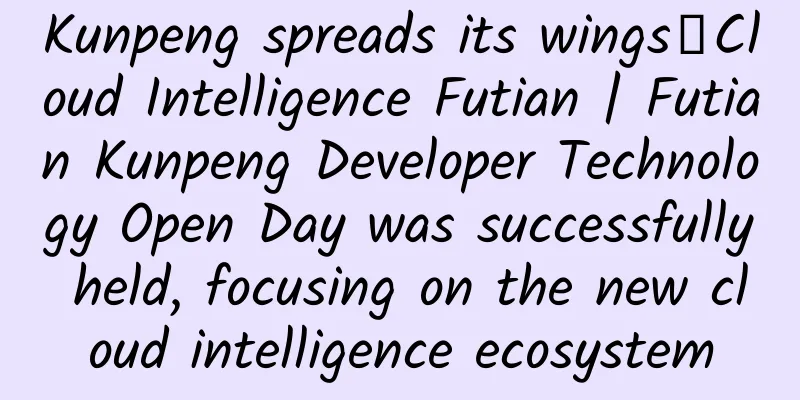Kunpeng spreads its wings﹡Cloud Intelligence Futian | Futian Kunpeng Developer Technology Open Day was successfully held, focusing on the new cloud intelligence ecosystem

|
[51CTO.com original article] On the afternoon of December 26, the Kunpeng Technology Open Day with the theme of "Kunpeng Spreads Wings ﹡ Cloud Intelligence Futian" was successfully concluded at the New Generation Information Industry Park in Futian District, Shenzhen. The event was guided by the Futian District Science and Technology Innovation Bureau, hosted by the Kunpeng Industry Source Innovation Center, undertaken by Huawei Cloud Futian Artificial Intelligence and Software Development Cloud Innovation Center, and co-organized by Shenzhen Futian New Generation Smart Operation Service Co., Ltd. The event invited senior experts in the field of Huawei Cloud and Huawei Kunpeng computing to introduce the strategic development of the Kunpeng computing industry ecosystem, industry strength analysis, Kunpeng + big data solutions, Kunpeng development tool suite application migration and other content to the majority of developers, and in-depth discussions on the promotion and implementation of Kunpeng industry solutions. The event attracted hundreds of developers to the scene, sharing this technology feast from the end of the year in the deep winter. Wei Rong, senior account manager of Huawei Cloud Industry Cloud, took the lead in delivering a keynote speech on "Open collaboration, win-win cooperation, and building a new Kunpeng ecosystem". He said that with the development of the economy and society, relying solely on single computing power can no longer meet the needs of contemporary technological development. The era of multi-scenario has arrived, which has put forward higher demands for the diversification of computing power. Against this background, the Kunpeng computing industry has emerged. In September 2019, Huawei and the Shenzhen Municipal Government signed a strategic cooperation agreement, planning to jointly build a national Kunpeng industry demonstration zone, forming a benchmark demonstration role in the country, and gathering more partners to join the Kunpeng ecosystem to win a new computing future. Gao Xiaopan, senior solution architect of Huawei Kunpeng, then introduced the Huawei Kunpeng computing cloud platform solution. He pointed out that with the emergence of new technologies such as 5G, artificial intelligence and big data, many industries have begun to deploy applications based on IAAS, PAAS and other platforms. The traditional industry market has built a mature and stable IaaS platform based on KVM technology, and the Internet industry has built a flexible, standardized and lightweight PaaS platform based on Docker container technology. Gao Xiaopan emphasized that the Kunpeng cloud platform has the following advantages: First, it enables the ecosystem and supports open source KVM, Docker, Huawei Cloud hybrid cloud and domestic mainstream commercial cloud platforms; second, Kunpeng has high overall performance, multi-core architecture, and a single-machine CPU density that is higher than X86. The entire machine can create more virtual machines and provide stronger computing power; third, the performance is more stable. The underlying Kunpeng CPU is implemented from the physical core, and there is no sharing between CPUs, so the performance degradation in high-load pressure scenarios is relatively small; fourth, it reduces the Capex of the server, and building virtual machines of the same size requires a smaller number of server clusters; fifth, it supports smooth capacity expansion, supports the mixed deployment of Kunpeng and X86, and realizes smooth capacity expansion of the existing network cluster. Hao Xingjun, senior architect of Huawei Cloud Big Data, shared his experience on "Kunpeng + Storage and Computing Separation - Maximizing the Value of Every Bit of Data", and elaborated on Huawei Cloud's technical thinking and practice in the field of big data. He proposed that the purpose of system architecture design is to maximize the utilization of digital resources without overloading the system. In response to the problems of difficult expansion, low resource utilization, low reliability and low operation and maintenance efficiency in the traditional storage-computing integrated big data architecture, Huawei Cloud's "Storage and Computing Separation + Kunpeng" big data solution adopts a computing and storage separation architecture. This solution can be elastically scaled independently on demand according to actual business needs, with more accurate and reasonable resource matching, and greatly improved resource utilization of big data clusters. Another direction to improve the utilization of big data resources is to combine software and hardware, vertically optimize, and make full use of the multi-core high concurrency capabilities of Huawei Kunpeng processors, and combine its own technical advantages to provide multiple types of optimization to fully release the hardware computing power. In addition, Huawei always adheres to the open ecosystem, continuously outputs power to the open source community, and attracts more developers to build the big data solutions provided by Huawei. Guo Maoming, solution architect of Huawei Cloud Futian Artificial Intelligence and Software Development Cloud Innovation Center, delivered a keynote speech on "Kunpeng + AI, Huawei Cloud EI helps the industry upgrade to intelligence" at the meeting. He first mentioned that Huawei Cloud Futian Artificial Intelligence and Software Development Cloud Innovation Center is the first innovation center jointly launched by Huawei and the local government in Shenzhen to carry out targeted transformation and upgrading of local industries. The innovation center can not only provide transformation-related artificial intelligence and software development cloud services and technical support for enterprises in Futian District, but also provide joint marketing, talent training and other services, continuously assisting the intelligent upgrading of industries in Futian District and building a cloud innovation ecosystem. Regarding Huawei's product practices in the field of artificial intelligence, Guo Maoming focused on introducing Huawei Cloud's one-stop AI development platform ModelArts, which can help users manage the entire life cycle, including AI development and operation phase management, and provide faster and more effective solutions in various links such as data processing, model training, model management, model deployment, and AI market. In addition, this platform integrates many of Huawei's self-developed algorithms and industry classic algorithm models, and also supports code-free AI development through transfer learning, making it easier for developers to quickly carry out innovative activities with the help of ModelArts and find more possibilities for AI scenario implementation. Kong Lingbin, senior solution architect of Huawei Kunpeng, shared the "Introduction to Practical Software Migration Cases" at the end, focusing on three types of migration cases: SO library migration, Maven project migration, and Python project migration. He also summarized the general migration ideas from the entry point, analysis process, and solution process. Regarding the dependency analysis issues involved in the migration process, he pointed out that after analyzing the incompatible component information, the component can be recompiled and installed on the platform by searching the dependency source. If the source code of commercial closed-source software is not available, it is usually replaced with software that can be compiled with source code or adapted for Kunpeng compatibility. For applications based on compiled languages such as C/C++/go, during the dependency analysis of software migration, the first thing to do is to observe whether the dependent components are open source, whether they can be solved by compiling the source code, or find a replacement solution; for applications built with Maven, check whether the network is unobstructed, whether the configuration is correct, and whether the jar package can be obtained correctly based on the information received from Maven. If the jar package is correct, check whether there is a dependency on C. If there is a dependency, migrate it or replace the dependent file; Python applications are similar to JAVA applications, and the dependent library must be recompiled or replaced for calls involving C. Under the background of the digital wave, the Kunpeng computing industry ecosystem is full of huge imagination and development potential. The construction of the industry ecosystem has never been separated from the efforts of all parties, nor from the support of many developers. This event built a bridge of communication between local developers and Kunpeng computing experts through the sharing of hot technologies, which drew a period for the 2020 Kunpeng Technology Salon and sounded the prelude to the prosperity of the Kunpeng technology exchange "circle of friends" in the coming year.
[51CTO original article, please indicate the original author and source as 51CTO.com when reprinting on partner sites] |
<<: British media: Britain is likely to fail to achieve broadband and 5G targets by 2025
Recommend
Let's talk about 3CC, which is very popular this year
The day before yesterday, I published an article ...
How did Beiming Software and Huawei achieve new highs in cooperation performance?
[51CTO.com original article] In the context of th...
WOT Cheng Chao: Alibaba's monitoring development path from automation to intelligence
[51CTO.com original article] On May 18-19, 2018, ...
Silicon multiplexer chips will drive the development of 6G next-generation communications
A new design of ultra-small silicon chip, called ...
HostKvm New Year Offer: Hong Kong Cloud 4G Memory Package Annual Payment Discount Only $60/Year
HostKvm is a foreign VPS service provider founded...
How to integrate network management tools
In the process of curbing the proliferation of ne...
CMIVPS offers 10% off on Seattle high-security VPS, AS4837 line optimization starting at $6.1/month
CMIVPS recently launched a new VPS host in the US...
DediPath Summer Promotion: 29% off on dedicated servers, 1Gbps unlimited traffic servers starting at $35.5/month, 35% off on VPS hosting
DediPath has released its latest summer promotion...
25 Fudao companies cooperated to develop the scada system, committed to the construction of industrial big data platform and industrial Internet
At present, it is a global consensus that the Ind...
API security representative manufacturer! Ruishu Information is selected into China's data security development roadmap
On August 26, IDC, a leading global IT research a...
New trends: eight directions of development of the Internet of Things industry
The Internet of Things (IoT) is a technological r...
Sharktech: 1Gbps unlimited traffic high-security server starting at $59/month, Los Angeles data center
I saw a friend looking for a 1Gbps unlimited traf...
Increase power consumption? US operators recommend users turn off 5G networks to save power
Currently, 5G construction is in full swing aroun...
4G networks are getting slower and slower? This may be true, but there is absolutely no conspiracy!
Since the commercialization of 5G networks, the s...
Data center "cloudification" solves the embarrassment of virtualization
Virtualization technology is being used more and ...









